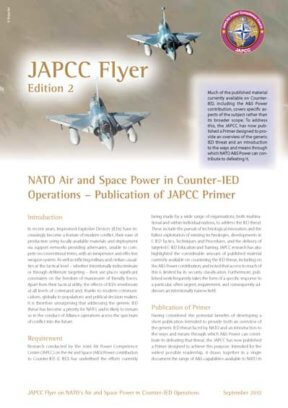Introduction
In recent years, Improvised Explosive Devices (IEDs) have increasingly become a feature of modern conflict, their ease of production using locally-available materials and deployment via support networks providing adversaries, unable to compete on conventional terms, with an inexpensive and effective weapon system. As well as inflicting military and civilian casualties at the tactical level – whether intentionally indiscriminate or through deliberate targeting – their use places significant constraints on the freedom of manoeuvre of friendly forces. Apart from their tactical utility, the effects of IEDs reverberate at all levels of command and, thanks to modern communications, globally to populations and political decision-makers. It is therefore unsurprising that addressing the generic IED threat has become a priority for NATO, and is likely to remain so in the conduct of Alliance operations across the spectrum of conflict into the future.
Requirement
Research conducted by the Joint Air Power Competence Centre (JAPCC) on the Air and Space (A&S) Power contribution to Counter-IED (C-IED) has underlined the efforts currently being made by a wide range of organisations, both multinational and within individual nations, to address the IED threat. These include the pursuit of technological innovation and the fullest exploitation of existing technologies, developments in C-IED Tactics, Techniques and Procedures, and the delivery of targeted C-IED Education and Training. JAPCC research has also highlighted the considerable amount of published material currently available on countering the IED threat, including on the A&S Power contribution, and noted that access to much of this is limited by its security classification. Furthermore, published work frequently takes the form of a specific response to a particular, often urgent, requirement, and consequently addresses an intentionally narrow field.
Publication of Primer
Having considered the potential benefits of developing a short publication intended to provide both an overview of the generic IED threat faced by NATO and an introduction to the ways and means through which A&S Power can contribute to defeating that threat, the JAPCC has now published a Primer designed to achieve this purpose. Intended for the widest possible readership, it draws together in a single document the range of A&S capabilities available to NATO in countering the IED threat, and the factors influencing the employment of those capabilities. In challenging the perception that, in C-IED terms, A&S effort focuses primarily on Intelligence, Surveillance and Reconnaissance (ISR), the Primer sets out to describe the breadth of capabilities and the part they play, including the contributions made by Air Mobility, the delivery of kinetic effects and, in the realm of Information Operations, through the use of such techniques as Shows of Presence (SoP) and Shows of Force (SoF). Each of these contributions is considered by the Primer in terms of its employment to defeat IEDs once emplaced and in attacking the systems and networks that support their use. It considers how the inherent characteristics of different capabilities lend themselves to different aspects of the C-IED fight. For example, while fast jets offer flexibility, speed and responsiveness and the ability to conduct SoP, SoF and Non-Traditional ISR (NTISR), unmanned aircraft provide an unrivalled degree of discreet, persistent ISR.
Education and Training
Key to the successful application of A&S Power capabilities in C-IED operations is relevant and focussed Education and Training (E&T). The Primer identifies a number of E&T audiences comprising, at one end of the spectrum, those specialists whose primary duties are closely associated with C-IED operations and for whom E&T is essential and, at the other, those audiences requiring E&T to provide a more general understanding and awareness of the IED threat and their role in countering it. To be effective, such E&T needs to be kept under constant review to ensure its currency.
Make a Network to Break a Network
The Primer acknowledges that any review of the A&S Power contribution to C-IED operations is likely to focus to an extent on an assessment of the strengths and limitations of airborne and Space-based platforms themselves, their sensor capabilities and weapon systems. While it considers this, it stresses that A&S capabilities constitute only the front-end of an inherently Joint process, supported by a network of organisational structures and procedures designed to plan, coordinate and deliver the required effect, and to analyse and disseminate the results. Only by exploiting these underlying processes can A&S Power contribute fully to the defeat of both the device itself, and the systems that support its use. This need to ‘make a network to break a network’, together with optimisation of the technological capabilities currently available, represent critical factors in the A&S Power contribution to C-IED operations.









